The Presence of the Past in French Art, 1870–1905: Modernity and Continuity by Richard Thomson
Reviewed by Neil McWilliamNeil McWilliam
Walter H. Annenberg Professor Emeritus of Art & Art History
Duke University
Email the author: n.mcwilliam[at]duke.edu
Citation: Neil McWilliam, book review of The Presence of the Past in French Art, 1870–1905: Modernity and Continuity by Richard Thomson, Nineteenth-Century Art Worldwide 23, no. 1 (Spring 2024), https://doi.org/10.29411/ncaw.2024.23.1.12.
This work is licensed under a Creative Commons Attribution-NonCommercial 4.0 International License  unless otherwise noted.
unless otherwise noted.
Your browser will either open the file, download it to a folder, or display a dialog with options.
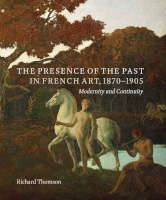
Richard Thomson,
The Presence of the Past in French Art, 1870–1905: Modernity and Continuity.
New Haven: Yale University Press, 2021.
288 pp.; 246 color and 12 b&w illus.; bibliography; index.
$70.00 (hardback)
ISBN: 9780300257106
In May 1905 the painter Émile Bernard (1868–1941) announced the “foundation of a group of traditionists,” whose members aspired to salvage contemporary French art from the twin perils of “the baleful routine of the École des Beaux-Arts, the principal cause of the harm from which art currently suffers” and “the corrupt invasion of lethal systems and prejudiced opposition.” Confronted by this conspiracy between “ideas of anarchy, routine, Ignorance, and a Thirst for Publicity,” Bernard called upon like-minded colleagues to join him in upholding “the eternal Tradition of true Art.”[1] Bernard’s crusade, pursued in his journal La Rénovation esthétique (May 1905–April 1910) and in a series of paintings that ostensibly revitalized the lessons of the past, attracted few followers of note, but does highlight—in perhaps its most extreme form—a preoccupation with the continuing relevance of the Old Masters in a period often retrospectively understood from the partial vantage point of novelty and innovation associated with modernism. It is this doxa that Richard Thomson sets out to challenge in his important and wide-ranging new study, The Presence of the Past in French Art, 1870–1905. Though Thomson briefly mentions Bernard, the painter’s fanatical devotion to the past makes him an outlier in a survey that primarily focuses upon the ways in which artistic tradition still resonated deeply in work produced by a broad spectrum of painters and sculptors. Eschewing Manichean distinctions between academy and avant-garde, Thomson demonstrates that, contrary to Bernard’s allegation, past precedent continued to provide a fertile source for artists seeking to break new ground as well as for those more readily recognized by the critical mainstream. Thomson focuses on three cultural lineages to prove his point: the classical tradition, to which he devotes three chapters, and which provides the conceptual backbone to his study; the cult of Rubens; and the impact of the quattrocento on modern French art. While these three visual categories limit the stylistic (and, as we will see, the ideological) scope of his study, its chronological sweep, extending from 1870 to 1905, as well as its encyclopedic range of visual evidence, offers the reader a richly nuanced survey of the formal interplay between past and present in late nineteenth-century French art.
The Presence of the Past is best understood as part of an ongoing project by Richard Thomson to fundamentally reinterpret French visual culture of the early Third Republic. This enterprise began with the publication in 2004 of The Troubled Republic, which explored “Visual Culture and Social Debate in France 1889–1900.”[2] This thematic investigation of the 1890s was followed in 2012 by a more expansive discussion of an overlooked (and generally underestimated) pictorial idiom: Art of the Actual: Naturalism and Style in Early Third Republic France, 1880–1900.[3] With The Presence of the Past, Thomson completes a trilogy that—particularly when considered in relation to his extensive monographic output on figures such as Claude Monet (1840–1926), Edgar Degas (1834–1917), and Henri de Toulouse-Lautrec (1864–1901)—represents a major contribution to the study of modern French art. In what follows, I will situate Thomson’s most recent installment in relation to his two earlier surveys and examine the ways in which his treatment of artists’ use of the past resonates with—and sometimes contradicts—themes developed in previous volumes. I will focus, too, on the different ways in which the idea of tradition, whether understood in terms of imitation, emulation, adaptation, misprision, pastiche, or resistance, might be expanded and further developed on the basis of the corpus assembled by Thomson and the interpretation he applies to it.
Like its predecessors, The Presence of the Past explicitly sets out to challenge received accounts and to “explore paths that diverge from typical modernist narratives” (15). In so doing, it follows the guiding formula of The Troubled Republic, whose goal Thomson described as “to re-introduce into the mainstream of art-historical debate neglected kinds of work, forgotten artists, discarded images that had great reputations and resonance during the 1890s” (TR 16). Building upon this, in Art of the Actual he presents the very act of taking naturalism seriously as in itself a challenge to scholarly consensus and its implicit disdain for the style’s alleged narrative legibility. “At a certain level this book is a polemic,” he asserts, with its corpus of works that “runs against many accepted attitudes to taste and systems of priorities which many art historians subliminally accept, content as we might be with jaded stylistic formulations” (AA 30). Though he perhaps exaggerates the degree to which the discipline remains in thrall to received narratives of artistic modernity, Thomson’s point is well taken. It is also well justified in the unfailingly engaging and pertinent array of objects that he has unearthed from provincial museums and public buildings, from comic journals to city squares. All three volumes challenge us to look anew at the art of the early Third Republic in its often disorienting diversity. Rather than offering little-known Salon favorites or the décor of a far-flung mairie as mere context for enhanced understanding of familiar canonical works, Thomson treats these endeavors on their own terms, while avoiding the promotional special pleading of much revisionist art history.
Such an approach is well to the fore in The Presence of the Past. Thomson divides his discussion of classicism into three separate, though overlapping, chapters. He begins with a survey of the early decades of the Republic, as naturalism found increasing favor in official circles, even as Pierre Puvis de Chavannes (1824–98) renewed classicism’s pictorial language in major projects for the Panthéon (1874–77), the Musée de Picardie in Amiens (1880–82), and the Grand Amphithéâtre in the Sorbonne (fig. 1). Thomson also discusses canvases by artists such as Émile Bin (1825–97), Luc-Olivier Merson (1846–1920), and Paul Milliet (1844–1918), and sculpture by Auguste Bartholdi (1834–1904) and Léopold Morice (1843–1920; fig. 2), suggesting that classicism retained prestige under the new regime as the visual expression of a culture still deeply embedded in what he describes as the national “mentalité” (a formulation to which I will return).
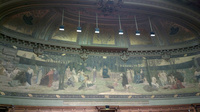
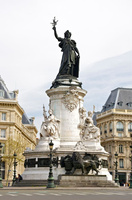
Thomson skews the perspective in his third chapter: “The Originality of Tradition: Classicism and the Avant-Garde.” Here, more familiar names come to the fore, with extended discussion of works by Degas, Paul Signac (1863–1935), Georges Seurat (1859–91), and Paul Cézanne (1839–1906). Thomson’s excavation of sources, such as the Louvre’s third-century Roman copy of a Greek marble known as the Vénus de Vienne (fig. 3) for Degas’s pastel Le Tub (fig. 4), or the parallel between Seurat’s Chahut (1889–90; Kröller-Müller Museum, Otterloo) and designs for Greek black-figure vases, are carefully argued and generally convincing, as is his skeptical take on art historians’ pursuit of comparisons between Cézanne and Nicolas Poussin (1594–1665). Thomson presents the (perhaps unsurprising) evidence of avant-garde artists’ continuing enthusiasm for, and indebtedness to, the classical tradition to argue for a far less rigid distinction between “advanced” and “mainstream”[4] artists’ cultural reference points. In doing so, he perhaps underplays significant differences in the ways such sources are interpreted in the works they inspire. Signac may have looked to Claude Lorrain (ca. 1600–82), as refracted through Crossing the Brook (fig. 5) by J. M. W. Turner (1775–1851), for his Capo di Noli (fig. 6), but the borrowing is of a different order from, say, the quotation of the Callipygian Venus (fig. 7) by Raphaël Collin (1850–1916) in his Été (fig. 8), discussed earlier in the chapter.
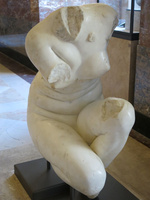
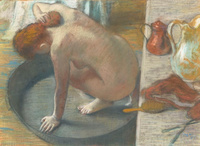
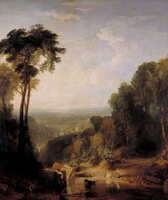
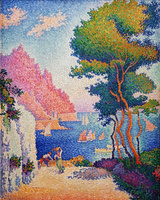
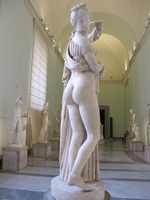
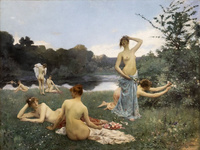
Thomson devotes his fifth chapter to a survey of “Classicism for the New Century.” Once again, emphasis is placed on classicism’s capacity to stimulate innovation, not least as artists responded to changing perceptions of the ancient world inspired by archaeological research and philosophical speculation. Debates over sculptural polychromy in the ancient world underpin discussions of the marble Tanagra by Jean-Léon Gérôme (1824–1904; fig. 9) and Henri Cros’s (1840–1907) pâte-de-verre relief L’Histoire du feu (The History of Fire, 1894–97; Musée des Arts Décoratifs, Paris), while Thomson traces the impact of Friedrich Nietzsche’s (1844–1900) The Birth of Tragedy (1872) on such Dionysian idylls as La Clarière by Henri-Edmond Cross (1856–1910; fig. 10).[5] Particularly suggestive are investigations of classicizing depictions of movement, in media ranging from paintings by Georges Desvallières (1861–1950) to the Sèvres figurines of Agathon Léonard (1841–1923) and performances by the dancers Loïe Fuller (1862–1928) and Isadora Duncan (1877–1927).
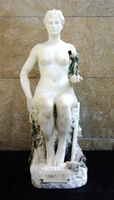
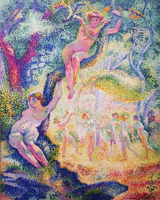
Interspersed between these three chapters, Thomson’s discussions of responses to Rubens (chapter 2) and to Italian art of the quattrocento (chapter 4) introduce perspectives that diverge formally from classical idealism whether through the sensual physicality of the Baroque or the “gaucherie” often associated with the so-called “Primitifs.” Thomson highlights the diverse ways in which Rubens served as a source for the boisterous naturalism of Alfred Roll’s (1846–1919) Fête de Silène (Feast of Silenus, 1879; Musée des Beaux-Arts, Ghent) as well as its sculptural counterpart, Le Triomphe de Silène (The Triumph of Silenus) by Jules Dalou (1838-1902; fig. 11). He describes, too, how Cézanne’s interest in Rubens can be traced in a rather surprising borrowing from the Medici cycle in his allegorical oddity L’Éternel Féminin (The Eternal Feminine, ca. 1880–82; J. Paul Getty Museum, Los Angeles), or how Renoir (1841–1919) adapted Rubens in his Judgment of Paris (fig. 12). Louis Anquetin (1861–1932), one of Émile Bernard’s comrades in arms, illustrates the repudiation of the avant-garde common to both artists. For the former cloisonnist, the discovery of Rubens during a visit to Belgium and Holland in 1894 provoked a sense of his own technical shortcomings that led him on a life-long crusade to rediscover neglected craft skills and to vie with his hero in producing gigantic, turbulent canvases that attracted only limited commercial and critical success (fig. 13).
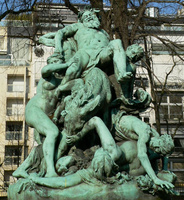
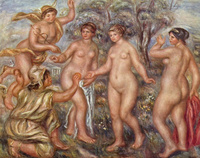
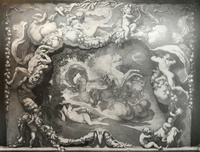
Thomson argues that, though interest in the quattrocento extended across the nineteenth century, its appeal to artists and wealthy collectors in France intensified after 1870. With the erosion of the authority of the École des Beaux-Arts and its favored canon dominated by masters of the High Renaissance, he suggests, artists began to investigate a broader range of sources, access to which was enhanced by increased circulation of photographs, engravings, and plaster reproductions. The examples he presents cover a broad spectrum, from a Saint Sébastien (1874; Musée d’Orsay, Paris) in which the devoutly Catholic painter and engraver Ferdinand Gaillard (1834–87) channels Giovanni Bellini (1430–1516), to borrowings from Andrea Mantegna (1431–1506) by Degas and Gustave Moreau (1826–98). Thomson situates quattrocento revivalism as an elite taste, whose influence percolated “from the top down” (165), attracting promoters such as the novelist Joris-Karl Huysmans (1848–1907) and the reactionary Catholic aesthete Joséphin Péladan (1858–1918). This vogue for early Italian masters, which found its way into advertising imagery, high fashion, and the decorative arts, was substantially boosted by the international craze for Sandro Botticelli (ca. 1445–1510), whose allure Thomson traces in works by Merson, Armand Point (1861–1932), and Paul Gauguin (1848–1903). Yet, alongside this fashionable aestheticist appeal, Thomson also notes how the fabled piety of Fra Angelico (ca. 1395–1455) captured the imagination of a committed believer such as Maurice Denis (1870–1943), inspiring works like the panels illustrating the Legend of Saint Hubert (fig. 14) that fused past and present to demonstrate the continuing vitality of faith in the modern world.
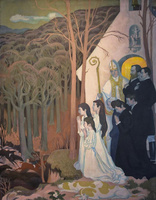
Though this brief summary gives some sense of the multiplicity of examples on which Thomson bases his discussion, what remains to be addressed is how he theorizes that material and the thesis it is intended to advance. In his introduction, Thomson describes The Presence of the Past as a work that prioritizes the study of art as an integral part of its historical moment. The book, he remarks, “seeks to probe . . . fusions of the stylistic and the ideological, the historical and the national” (15) and is animated by an interest in how “styles were shaped at this period by mentalities and social pressures” (10). At the same time, though, he affirms his methodological commitment to the centrality of the artwork, describing his emphasis as being “always on how things looked, with close visual analysis, and on what contemporaries made of such images and objects” (19). This is, indeed, the great strength of the book: Thomson is a sophisticated and perceptive viewer whose familiarity not only with late nineteenth-century visual culture but also with European art of the more distant past allows him to draw enlightening and often surprising analogies between artists and works. Yet, as Thomson notes in his introduction, this is “a book that does not have a single narrative but argues for interplay, complexity and contradiction” (19). In many ways, the book’s argument is invested in the accumulation of the examples it presents, which serve to assert the variety, vitality, and versatility with which artists of quite different aesthetic persuasions mined past art for present inspiration. Artists’ relationship with tradition, Thomson argues, “far from being feebly derivative or ploddingly academic, was in fact dynamic, purposeful, innovative and controversial” (10). Central to this dynamism, he suggests, was the fact that, for late nineteenth-century viewers, “Style was read, it had associations; it drew on history—and it was manipulable” (10). Thomson’s objective is to explore the “associations” that adhered to his three chosen stylistic categories through contextual readings that recover “a sense of the mentalities and textures of the period across the nation” (19) as they emerge in the visual culture it produced.
The priorities that frame Thomson’s challenge to what he presents as received readings of late nineteenth-century French art echo methodological points made in his earlier studies of the period. Art of the Actual, for example, is predicated on “understanding paintings within the process of historical mentalités rather than according to the structures of a latter-day modernist reading,” a process through which inherited “art-historical labels” are themselves called into question (AA 30–31). Thomson describes his approach to naturalist art of the period as breaking with modernist teleologies rooted in formalism: “My objective is to return all these kinds of painting to history, to their context under the Third Republic” (AA 3). “There is no question of revisionism here, then, but rather a respect for history and the contemporary mentalité” (AA 4). Similar ambitions already shape Thomson’s approach in The Troubled Republic, where he summarizes his project as being “to explore how imagery can help define and deepen our understanding of historical mentalités” (TR 14). This is an admirable remit, and one that Thomson has used to great effect in his sweeping review of visual culture under the Third Republic. It does, however, raise a number of issues that affect the scope and interpretative focus of The Presence of the Past and its historical understanding of cultural tradition as subject to ideological struggle in late nineteenth-century France.
In all three of his recent monographs, Thomson leans heavily on the heuristic value of what he variously terms “mentalités” or “mentalities.” The term is used in a variety of contexts and in both languages, seemingly interchangeably. As a methodological concept, it is perhaps most familiar in relation to the work of historians such as Philippe Ariès, Jacques Le Goff, or Carlo Ginzburg, and is generally associated with attempts to piece together the mental universe, the deep structures of thought and belief, as manifested in the habits of everyday life, particularly in the early modern period.[6] Thomson gestures towards this totalizing sense with references to “the wider national mentalité” (TR 25) or the “democratic and egalitarian principles so much to the fore in the modern mentalité” (AA 46). Typically, though, the term’s use is more restrictive: we are told, for example, that “the new discipline of crowd psychology had infiltrated the intellectual mentalité” (TR 72), that naturalism “set the cultural tone, shaped and suited the mentalité of the mainstream” (AA 1), or that “the republican mentalité . . . habitually linked contemporary France to classical antiquity” (PP 29). In the end, the term’s ubiquity works against its explanatory value, so that when we are told that “the production of art is framed by the predominant mentalités of the period” (PP 250), it is difficult to tell whether Thomson uses the term as a substitute for “ideologies,” and what sense is accorded to the act of “framing” in this broader cultural process. Elsewhere, Thomson rightly points to the social, regional, religious, educational, and political diversity that characterized late nineteenth-century France, yet this sits awkwardly at best with such remarks as his assertion that the “wider national mentality was steeped in Greco-Roman antiquity” (PP 15). In the end, the precise weight the term is intended to carry remains sufficiently elusive for it to detract from the historical analysis Thomson brings to bear on his visual corpus.
This is particularly apparent in Thomson’s identification of the contemporary, republican mentality with classical culture. “Throughout this period,” Thomson argues, “the classical past provided a set of values on which the Third Republic might lean” (PP 38). For the political class, he suggests, ancient history, mythology, and rhetoric offered a constant touchstone, allowing figures across the ideological spectrum to expatiate on the “linkage of the classical past and their current political credo” (PP 22). Yet, as the historian Jean El Gammal has demonstrated, both in parliamentary rhetoric and in the press, explicit references to Greece and Rome, and comparisons between classical civilization and contemporary France, were in fact much less widespread during the early Third Republic than under previous regimes.[7] Indeed, in Art of the Actual Thomson himself links the Republic’s promotion of naturalism to the priorities of a polity that set its face firmly towards the future and identified progress with the embrace of positivist values that sidelined the humanist legacy of which classicism was an integral part. Historians such as Martha Hanna have underscored the regime’s commitment towards “an intellectual culture predicated jointly upon Comtean positivism and Kantian ethics,” and have highlighted how university reforms of the 1880s and changes to the secondary school curriculum in 1902 promoted science, mathematics, and modern languages at the expense of classics and the humanities in general.[8] Significantly—and perhaps not surprisingly—it was the literary and artistic establishment at its most conservative, centered on the Institut, that in 1911 coalesced around the Ligue pour la Défense de la Culture Française, which called for the rehabilitation of the classics within a humanistic educational program reflective of “the genius of our race.”[9]
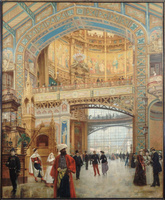
It would, of course, be misleading to claim (as contemporary critics sometimes did) that the Republic was actively hostile to France’s time-honored classical legacy, but it is clear that its values and terms of reference tended towards more current, utilitarian priorities. Indeed, Thomson provides a telling instance of the integration of a classical motif into an apparently up-to-the-minute setting: the view of the central dome at the Exposition Universelle of 1889 by Louis Béroud (1852–1930, fig. 15) portrays the imposing metallic structure decorated with a classical personification of La Céramique by Merson (1888; La Piscine—Musée d’Art et d’Industrie André Diligent, Roubaix). Yet, for the regime’s critics, such gestures merely served as further proof of the debasement of the nation’s cultural legacy and its subordination to crass materialism.[10] As Thomson recognizes, figures such as the poet, essayist, and political agitator Charles Maurras (1868–1952) or the literary critic Ferdinand Brunetière (1849–1906) deployed classicism and France’s ostensibly Latin identity as a weapon in the struggle against the culture of democratic republicanism. This conservative appropriation of classicism was in many ways more vigorous—indeed, aggressive—than the Republic’s championship of antiquity. Embracing both the Grand Siècle’s classical legacy of art and literature as well as a celebration of the indelible trace of Greco-Roman civilization on Provence and the Mediterranean coast,[11] conservatives saw classicism as the embodiment of harmony, hierarchy, and discipline in a formal analogy to an ideally ordered polity. For the anti-republican right, classicism was invested with values that were distinctively French and that underwrote a reaction against the cultural cosmopolitanism they accused of subverting indigenous tradition. Thus in 1895 the poet (and future royalist) Ernest Raynaud (1864–1936) praised the École Romane, a literary group established in 1891 by Maurras and the Franco-Greek poet Jean Moréas (1856–1910), for advancing “the return in both thought and style to balance and harmony. . . . We have undertaken to defend the heritage of the Latin muses, using our own native taste for order, measure, and harmony to oppose the freakish inventions, the inconceivable chaos of foreigners, to fight with all our strength for the health of the French spirit and the reign of Beauty.”[12]
Debates around classicism, in both literature and visual art, illustrate the contentious ways that cultural tradition could be activated in conflicts over national identity and political ideology in a country where artistic prowess was closely identified with international prestige. Thomson recognizes this dimension of the problem, though his close reading of artworks tends to eclipse consideration of key issues that would illuminate the fusion of the stylistic and the ideological that he sets out to explore. Despite references to historians such as the belligerently nationalist Louvre curator Louis Courajod (1841–96) or seminal events such as the 1904 Exposition des Primitifs français, for example, Thomson engages only sporadically with the impact of art history’s development as a discipline during the crucial decades covered by his study. His priorities clearly lie elsewhere, but, as recent scholarship convincingly demonstrates,[13] art historians’ contribution to defining and disrupting cultural genealogies, often with barely concealed ideological motivation, shaped the ways in which individual artworks, artists, and national schools could be conscripted into contemporary debates about the legacies of the past on current production.
In his introduction, Thomson justifies his choice of the three historical styles selected for study and remarks, in relation to his focus on quattrocento Italy: “Other fifteenth-century work—for example, from Flanders and indeed France itself—is not brought into play, not least because French culture had long been taught to look to Italy for aesthetic authority” (PP 10). Such a preconception, and the options it underwrites, occludes one of the major controversies that divided art historians, critics, and indeed artists themselves, over the historical roots of French art and the lessons that contemporaries should draw in discriminating between diverse national schools and traditions. It is precisely during the period covered by The Presence of the Past that debates over the origins and character of the French school reached a new pitch, challenging—often for openly ideological reasons—the tutelage that Italian culture had allegedly exerted over France since the sixteenth century. Many champions of French medieval art insisted on the existence of a vigorous vernacular tradition deeply rooted in the character and beliefs of simple craftsmen, whose clear-eyed naturalism was a world away from the arid sophistication imported from Italy through the patronage of François I (1494–1547) and his Bourbon successors. The art historian Louis Gonse (1846–1921; fig. 16), for example, celebrated French Gothic as a unique expression of the nation’s “inclinations of race, environment, and climate,” whose achievements grew out of a “national genius” characterized by “the love of progress, a natural taste for novelty, a fertile inventiveness, the need for logic and method, a particular mixture of prudence and boldness, a very delicate sense of measure and harmony.” As such, Gonse stresses the relevance of the Gothic to the “awakening of our personality that has been invaded by so many parasitic elements, stifled by classical pedagogy and opposed by the doctrinal authority of so-called traditions, but that remains fundamentally robust and ready to flower anew in vigorous shoots.”[14] As art historians such as Elizabeth Emery and Laura Morowitz have demonstrated, medieval revivalism cast a long shadow around 1900, from the vogue for early devotional woodcuts and modern pastiches promoted by Alfred Jarry (1873–1907) and Remy de Gourmont (1858–1915; fig. 17) to the decorative enamels produced by Armand Point and his workshop at Haute-Claire.[15] Drawing inspiration not only from ostensibly indigenous forms but also from medieval guild organizations, such artists were commended for reviving “the aesthetic traditions of our race,” as Pascal Forthuny (1872–1962) commented in 1899 on Point and his followers.[16]
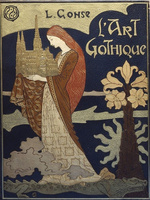
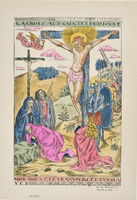
That this tradition stood in need of rediscovery was seen by many as an indictment of the alleged suppression of home-grown inventiveness by a stiff and mannered Italianate art that had been promoted by the crown and institutionalized with the foundation of the Académie Royale de Peinture et de Sculpture in 1648. Louis Courajod, in particular, was outspoken in denigrating Italian art of the High Renaissance and its aftermath for subverting indigenous production, and his call to arms was echoed by many. Reviewing the 1904 Primitifs exhibition, for example, the critic Maurice Le Blond (1877–1944) does not mince his words: “Never will we understand better than today the fatal influence exerted over our old popular art by the invasion of the Italian virtuosi. Arriving in the wake of the Medici, they replaced the charming naivete, the ingenious realism, and down-to-earth insight of our imagiers with an art that is superficial and conventional, solemn and aristocratic; and we must see this frivolous vogue for the Italian school as the origin of the baleful academicism whose tyranny still weighs on French art.”[17]
Yet the Renaissance did not lack for defenders. The art historian Louis Dimier (1865–1943), for example, campaigned tirelessly against efforts to dethrone the Italian masters, arguing that before the arrival at the palace of Fontainebleau in the 1530s of painters such as Rosso Fiorentino (1494–1540) and Francesco Primaticcio (1503–70), French art was provincial and directionless.[18] In the same vein—and from a political perspective diametrically opposed to the royalist Dimier—the painter and former Communard Paul Milliet, whose classical allegiances Thomson discusses at some length, criticized Courajod’s diatribes against the Renaissance and disparaged efforts to elevate the Middle Ages as a paradigm for contemporary artists to follow. Arguing that “In the history of French civilization, the Roman element has played a glorious role,” Milliet dismissed the Middle Ages as displaying the “savage and childlike tastes” of the barbarian invaders. “Unable to remain simple, powerless to copy nature, the first artists of the Middle Ages lost themselves in inextricable entanglements of bizarre and grimacing monsters which resemble the unhealthy visions of a drunkard, a hysterical woman, or a decadent poet.”[19]
Milliet himself, as Thomson argues, couched his progressive beliefs in a classical style inspired by his admiration for the Renaissance and its vision of antiquity. His sketches for the Salle des Mariages in the Mairie de Saint-Maur-des-Fossés, for example, envisage a Golden Age rooted in republican virtues but articulated in a visual language indebted to Italianate classicism (fig. 18). It is striking that Milliet was passed over for the commission at Saint-Maur in favor of a project by Paul Baudoüin (1844–1931; fig. 19) that is resolutely naturalistic and was commended by the selection committee as a “felicitous application of modernism to decoration.”[20] Baudouin’s victory indeed illustrates one of Thomson’s broader points, where he argues that naturalism presented the most substantial challenge to traditionally inflected artistic styles during this period, not least because of its promotion by the Republic as an accessible formal language appropriate for conveying civic ideals to a mass public. Yet naturalism itself was understood as drawing upon a tradition that, crucially, was defined as distinctively French. From episodes of everyday life captured on medieval capitals to a pictorial lineage extending from the Le Nain brothers (ca. 1600–48, ca. 1603–48, 1607–77) through Jean-Siméon Chardin (1699–1779) to Gustave Courbet (1819–77) and François Bonvin (1817–87), naturalism was endowed with a history in which it was often viewed as the visual expression of a national genius for empirical observation: the curator Henri Bouchot, for example, introduced his 1904 exhibition of Les Primitifs français (fig. 20) by extolling the French “impulse for naturalism, humanity and truth, while our neighbors long remained entrenched in their byzantine and traditional decorations.”[21] Some thirty years later, the celebrated exhibition Les peintres de la réalité au XVIIe siècle consecrated this idea of a distinctive national tradition of naturalism which the curator Paul Jamot (1863–1939), while recognizing the cultural contribution of Italy, extolled as sustaining “a human and universal art that is good not only for France, but for the whole world.”[22]

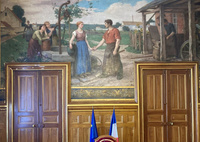
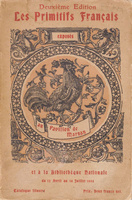
Perhaps surprisingly, The Presence of the Past refers only glancingly to the Académie and the École des Beaux-Arts, institutions still seen in the late nineteenth century, however grudgingly by many of their critics, as vested with the task of transmitting the lessons of the past to a rising generation and with fostering France’s reputed artistic supremacy. Faced with mounting criticism and disconcerted by growing stylistic diversity, academicians voiced their concern over what the painter Gustave Boulanger (1824–88) described in 1885 as “the search for originality for every reason and no reason at all, of originality at all costs, in a word, for what is bizarre.” Boulanger warned his students against naturalism—“scenes of the banal and everyday on canvases of a colossal scale,” which achieved only “the prosaic and vulgar”—and against plein-air painting and a looseness of facture which, in contrast to the examples of Rubens and Michelangelo, demonstrated only “impotence and idleness.” It is the beauty of nature, and the work of past masters who best captured that beauty, that Boulanger recommends as enduring touchstones, as he calls for a “vigorous reaction” to reassert traditional values.[23] Boulanger was far from unique in making such appeals, which are a regular feature of speeches by academicians congratulating successful students on the eve of their departure for Rome and of reports by those same academicians regularly castigating students for the quality of work submitted as envois from Rome. What is surprising, however, is how in his own work an artist such as Boulanger scarcely models the principles he asserted in 1885 (fig. 21)—and how a broadly similar judgment could be leveled at other academicians of the period, from Carolus-Duran (1837–1917) or Léon Bonnat (1833–1922) to Édouard Detaille (1848–1912) or Henri Gervex (1852–1929). Indeed, many successful Prix de Rome painters in the decades before 1914, including Charles Lebayle (1856–98; fig. 22), Gaston Larée (1867–1940; fig. 23), and Gabriel Girodon (1884–1941; fig. 24), won the award despite their often unapologetic naturalism, while few laureates persisted in pursuing what is generally identified as an academic idealism. This oddly ambivalent relationship to the art of the past—sustained within a classical tradition that still frequently provided a thematic source for the prize competition—is in itself intriguing and would merit consideration as an unexpected deviation from the institution’s aesthetic legacy and apparent raison d’être.
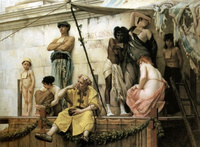
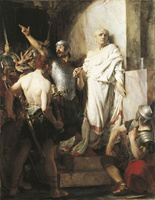
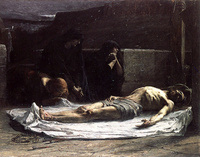
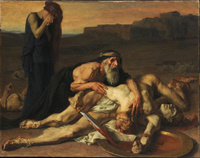
Though Thomson argues that after 1900 artists were less receptive to the stylistic legacies he traces in The Presence of the Past, debates over cultural tradition and its proper place in supporting future artistic achievement arguably continued with increased intensity in the opening decades of the new century. Christopher Green, for example, has offered a finely nuanced discussion of “modernism and the re-invention of tradition” between 1900 and 1918, where he argues: “From the beginning of the century, modernism in France was as regularly linked to notions of tradition as it was to notions and experiences of modernity. . . . Between 1900 and 1940, artists in France did not merely identify with tradition, they continually recreated ‘tradition,’ spawning new notions of it alongside the critics and art historians.”[24] Examples such as the discovery of early Tuscan art by André Derain (1880–1954), or the ongoing dialogue with antiquity in the work of Aristide Maillol (1861–1944) and Maurice Denis (both of whose pre-war classicizing works Thomson discusses), point to an enduring curiosity about the art of the past that is worlds away from the iconoclastic bravado of the Italian futurists. Indeed, three years after their provocative calls in 1909 to embrace the dynamism of modern life by burning the libraries and flooding the museums, they singled out figures such as Pablo Picasso (1881–1973), Georges Braque (1882–1963), André Derain, Jean Metzinger (1883–1956), Henri Le Fauconnier (1881–1946), Albert Gleizes (1881–1953), Fernand Léger (1881–1955), and André Lhote (1885–1962) precisely because of their “masked academicism,” revealed through an alleged servitude to tradition: “They obstinately continue to paint objects motionless, frozen, and all the static aspects of Nature; they worship the traditionalism of Poussin, of Ingres, of Corot, aging and petrifying their art with an obstinate attachment to the past, which to our eyes remains incomprehensible.”[25] However tendentious such a charge appears in retrospect, the past undoubtedly retained a pervasive allure in pre-war Paris and continued to resonate in complex ways with emergent aesthetics and—at times—regressive ideologies. As Thomson convincingly demonstrates, across a broad range of stylistic affinities, institutional sites, and doctrinal allegiances, late nineteenth-century French artists still drew inspiration from the past even as the increased tempo of modern life apparently demanded expression in new cultural languages. Indeed, the allure of tradition could act both as a countervailing force, or as a complement, to the aesthetic interpretation of contemporary experience well into the twentieth century.
Notes
All translations are by the author, unless otherwise stated.
[1] “fondation d’un groupe traditionniste”; “la routine fâcheuse de l’École des beaux-arts, cause première du mal dont l’art souffre présentement”; “l’envahissement mécréant des systèmes meurtriers et des négations de parti-pris”; “par des idées d’anarchie, par la routine, l’Ignorance et le Désir de la Réclame”; “la Tradition éternelle de l’Art vrai.” [Émile Bernard], “Pour la fondation d’un groupe traditionniste,” [1905]. Four-page pamphlet reprinted in Neil McWilliam, ed., Émile Bernard. Au-delà de Pont-Aven (Paris: INHA, 2012), 72, https://books.openedition.org/inha/4774#tocfrom1n2.
[2] Richard Thomson, The Troubled Republic: Visual Culture and Social Debate in France 1889–1900 (New Haven and London: Yale University Press, 2004). Subsequent references embedded in the text as TR.
[3] Richard Thomson, Art of the Actual: Naturalism and Style in Early Third Republic France, 1880–1900 (New Haven and London: Yale University Press, 2012). Subsequent references embedded in the text as AA.
[4] This is my rather unsatisfactory terminology, not Thomson’s.
[5] For an excellent discussion of this theme, see Margaret Werth, The Joy of Life. The Idyllic in French Art, circa 1900 (Chicago: Chicago University Press, 2002), 214–17.
[6] For a useful overview, see François Dosse, “L’histoire des mentalités” in C. Delacroix, F. Dosse & P. Garcia, Les Courants historiques en France. XIXe-XXe siècle (Paris: Gallimard, 2007), 408–34.
[7] See Jean El Gammal, Politique et poids du passé dans la France ‘fin de siècle’ (Limoges: Presses Universitaires de Limoges, 1999), 432–52.
[8] See Martha Hanna, The Mobilization of Intellect: French Scholars and Writers during the Great War (Cambridge: Harvard University Press, 1996), 27. On university reform, the classic account is Claude Digeon, La Crise allemande de la pensée française (1870–1914) (Paris, Presses Universitaires de France, 1959), 364–83.
[9] “le génie de notre race.” Manifesto of the Ligue pour la défense de la culture française, Mercure de France, June 16, 1911, 895. Signatories from the Académie des Beaux-Arts included Jean-Paul Laurens, Fernand Cormon, Édouard Detaille, Pascal Dagnan-Bouveret, Léon Lhermitte, Denys Puech, Jean Antoine Injalbert, and René de Saint-Marceaux. The group’s activities were countered by the Ligue pour la culture moderne, whose members included the literary scholar Gustave Lanson and the philologist Ferdinand Brunot. For an excellent discussion of the tensions generated by republican promotion of the natural and social sciences at the expense of the classical humanities, see Gisèle Sapiro, “Défense et illustration de ‘l’honnête homme.’ Les hommes de lettres contre la sociologie,” Actes de la recherche en sciences sociales no. 153 (2004): 11–27.
[10] See, for example, the critique of the dome and other pavilions at the 1889 Exposition in Joris-Karl Huysmans, “Le Fer” in Écrits sur l’art 1867–1905, ed. Patrice Locmant (Paris: Bartillat, 2006), 413–18.
[11] See Neil McWilliam, “Opposing Strands: The Mediterranean as Site of Cultural Conflict around 1900,” Artl@s Bulletin volume 10, no. 2 (special issue: The Mediterranean of Artists: A Critical Modernity, 1880–1945), https://docs.lib.purdue.edu/artlas/vol10/iss2/2/.
[12] “nous avons entrepris de défendre le patrimoine des muses latines, d’opposer le goût d’ordre, de mesure et d’harmonie de notre race aux imaginations monstrueuses, à l’inconcevable chaos de l’étranger, et de lutter dans la mesure de nos forces, pour le salut de l’esprit français et le règne de la Beauté.” Ernest Raynaud, “L’École romane française,” Mercure de France, May 1, 1895, 145.
[13] See the important study by Michela Passini, La Fabrique de l’art national. Le nationalisme et les origines de l’histoire de l’art en France et en Allemagne 1870-1933 (Paris: Éditions de la Maison des sciences de l’homme, 2012). For an essential online resource, see Philippe Sénéchal and Claire Barbillon, eds., Dictionnaire critique des historiens de l’art actifs en France de la Révolution à la Première Guerre mondiale, which contains ca. 400 entries, https://www.inha.fr/.
[14] “convenances de race, de milieu et de climat”; “génie national”; “l’amour du progrès, un goût naturel pour la nouveauté, la fertilité d’invention, le besoin de logique et de méthode, un mélange singulier de prudence et de hardiesse, un sentiment très délicat de la mesure et de l’harmonie”; “réveil de notre personnalité envahie par tous les éléments parasites, étouffée par la pédagogie classique et combattue par l’autorité doctrinale des soi-disant traditions, mais, au fond, toujours vivace et prête à s’épanouir en de vigoureux rejets.” Louis Gonse, L’Art gothique (Paris: Librairies-Imprimeries Réunies, n.d. [1892]), 18, 46.
[15] Elizabeth Emery and Laura Morowitz, Consuming the Past: The Medieval Revival in fin-de-siècle France (Aldershot: Ashgate, 2003). See also the extremely useful study by Janine R. Dakyns, The Middle Ages in French Literature 1851–1900 (Oxford: Oxford University Press, 1973).
[16] “les traditions esthétiques de notre race.” Pascal Forthuny, “Armand Point et Haute-Claire,” Revue des arts décoratifs no. 8 (1899): 246.
[17] “Jamais nous ne comprendrons mieux qu’aujourd’hui l’influence fatale qu’exerça sur notre vieil art populaire l’invasion des virtuoses italiens. Venus à la suite des Médicis, ils substituèrent à la naïveté charmante, à l’ingénuité réaliste, à la pénétration familière de nos imagiers un art factice et conventionnel, solennel et aristocratique; et il faut voir dans ce frivole engouement pour l’école italienne l’origine du néfaste académisme dont la dictature continue de peser sur l’art français.” Maurice Le Blond, “Les Primitifs français,” L’Aurore, April 13, 1904.
[18] On Dimier, see Neil McWilliam, The Aesthetics of Reaction: Tradition, Faith, Identity & the Visual Arts in France, 1900–1914 (Turnhout: Brepols, 2021), 166–74; and Michela Passini, “Il ‘Primatice’ di Louis Dimier. La scuola di Fontainebleau e la storiografica francese di fine ottocento: le ragioni di un rifuto” in Primaticcio e le arti alla corte di Francia, ed. C. Occhipinti (Rome: UniversItalia, 2011), 331–52.
[19] “Dans l’histoire de la civilisation française, l’élément romain a joué un rôle glorieux”; “Incapables de rester simples, impuissants à copier la nature, les premiers artistes du moyen-âge s’embrouillent dans des enchevêtrements inextricables de monstres bizarres et grimaçants qui semblent les visions malsaines d’un homme ivre, d’une femme histérique ou d’un poète décadent.” Paul Milliet, “Comment se font les renaissances,” Journal des artistes, no. 20 (May 17, 1896): 1149–50 and no. 22 (May 31, 1896): 1465–66. The extracts cited here appear on p. 1465 & 1449–50. The text is drawn from a lecture given by Milliet on April 29, 1896 to the Société d’études italiennes at the Sorbonne. It is preceded by a letter from Milliet to Albert Kaempfen, director of the École du Louvre, attacking Louis Courajod for lectures in which the curator accuses admirers of the Renaissance of being “traîtres à la Patrie” and covering his opponents with “imprécations odurières.”
[20] “heureuse application du modernisme à la décoration.” Cited in Le Triomphe des mairies. Grands Décors républicains à Paris 1870–1914, exh. cat. (Paris: Petit Palais, 1987), 129. On Milliet, see also L’Âge d’or. Paradis, utopies et rêves de bonheur de Brueghel à Signac, exh. cat. (Ornans: Musée Courbet, 2023), 141.
[21] “nos tendances naturalistes, humaines et variées, alors que nos voisins resteront plus longtemps figés dans leurs décorations byzantines et traditionnelles.” Henri Bouchot, “Introduction,” Les Primitifs français 1292–1500. Complément documentaire au catalogue officiel de l’exposition (Paris: Librairie de l’art ancien et moderne, 1904), 10.
[22] “bon non pas pour la seule France, mais pour le monde entier.” Paul Jamot, “Préface,” Les peintres de la réalité en France au XVIIe siècle, exh. cat. (Paris: Musée de l’Orangerie, 1934), XXVII. On this seminal exhibition and its contemporary setting, see Pierre Georgel’s outstanding exh. cat. Orangerie, 1934. Les “peintres de réalité” (Paris: Musée de l’Orangerie, 2007).
[23] “la recherche de l’originalité à propos de tout et à propos de rien, de l’originalité quand même, de la bizarrerie en un mot”; “des scènes d’une donnée courante et banale sur des toiles de proportions colossales”; “prosaïsme et vulgarité”; “l’impuissance et la paresse”; “une vigoureuse réaction.” Gustave Boulanger, À nos élèves. Discours sur les tendances actuelles de l’école française et sur la nécessité d’un enseignement artistique (Paris: Lahure, [1885]), 4, 6, 5, 8, 10. For a useful discussion of this speech, see Sophie Schvalberg, Le Modèle grec dans l’art français 1815–1914 (Rennes: Presses Universitaires de Rennes, 2014), 272–75.
[24] Christopher Green, Art in France 1900–1940 (New Haven & London: Yale University Press, 2000), 185–86.
[25] Umberto Boccioni, Carlo D. Carrà, Luigi Russolo, Giacomo Balla, Gino Severini, “Les Exposants au public” in Les Futuristes italiens, exh. cat. (Paris: Galerie Bernheim-Jeune & cie, February 5–24, 1912), 2. The citation comes from the translated introduction to the catalogue for the London showing of the exhibition at the Sackeville Gallery in March 1912.